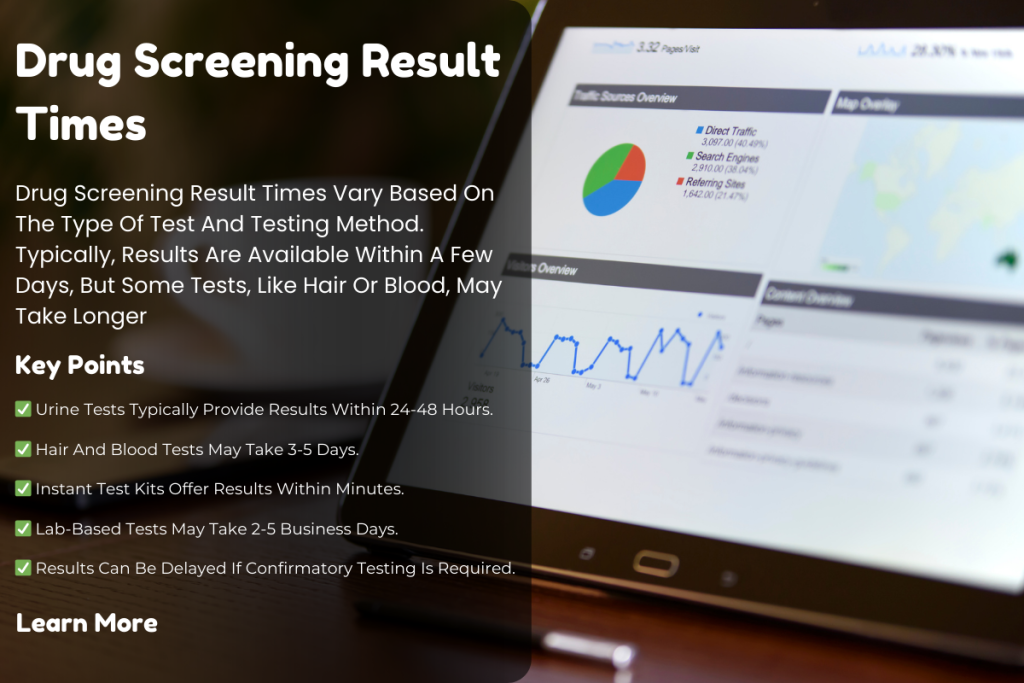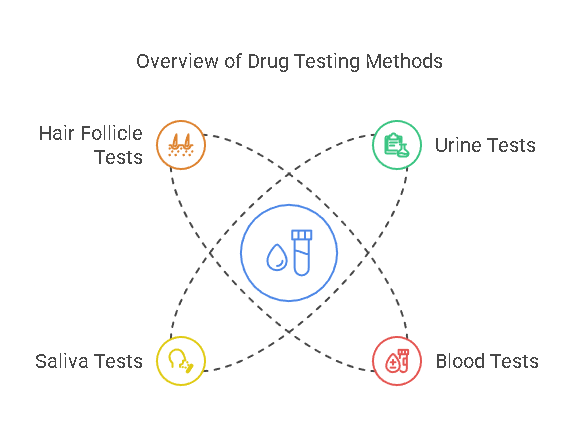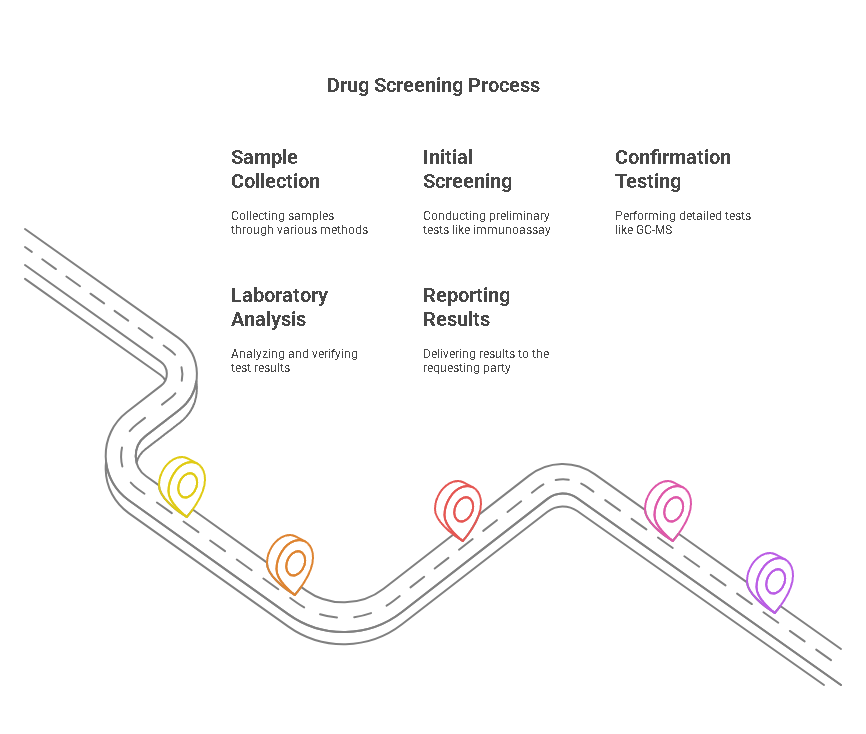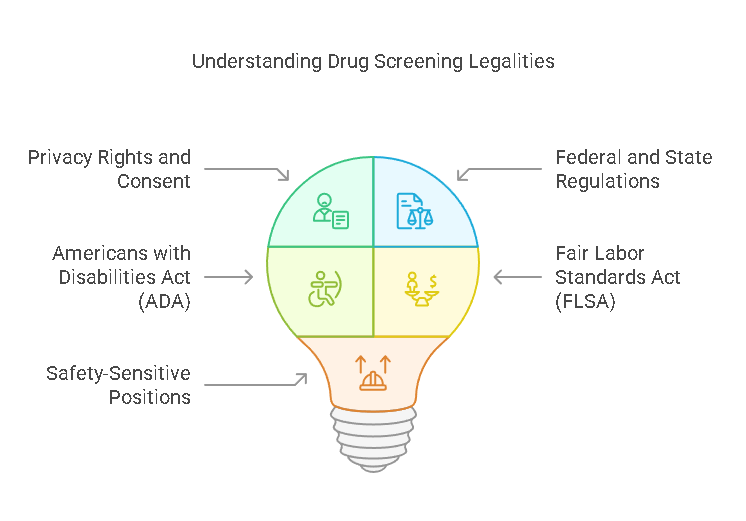Drug Screening Result Times Factors, Process, and Legal Insights

Introduction to Drug Screening and Result Times
What is Drug Screening and Why is It Important?
Drug screening is the practice of testing biological samples (such as urine, blood, saliva, or hair) to detect the presence of drugs or alcohol. This practice is crucial across various sectors, from employment to healthcare, helping to ensure safety, compliance, and health monitoring. Drug tests can identify recent use of illicit substances, prescription drugs, or even alcohol consumption, and are widely used in industries where safety and performance are of paramount importance.
In the workplace, drug screening helps reduce accidents, increase productivity, and mitigate risks related to substance abuse. Employers often implement drug testing as part of pre-employment checks, random screenings, or post-incident investigations. It serves not only as a deterrent but also as a means to monitor employees and maintain a safe working environment.
In medical contexts, drug screenings can be used for monitoring patient compliance with prescribed medications or identifying potential issues such as addiction, overdose, or side effects. Healthcare providers use these tests to ensure that medications do not interact negatively with other drugs a patient may be using, or to help diagnose certain conditions that might otherwise go undetected.
Types of Drug Tests

There are several different types of drug tests available, each with its strengths and weaknesses. The method chosen largely depends on the purpose of the test, the substances being tested for, and how recent the drug use is. The four most commonly used drug testing methods are urine, blood, saliva, and hair follicle tests.
- Urine Drug Tests: Urine tests are by far the most common and cost-effective form of drug screening. These tests are capable of detecting the presence of drugs in the system for several days to a week after use. Urine tests can detect a wide range of substances, including marijuana, cocaine, opiates, and amphetamines. They are widely used in employment drug testing and can also be used in medical and legal settings.
- Blood Drug Tests: While blood tests are more invasive and costly, they are considered the most accurate method for detecting drugs in the body. They are typically used in situations where it’s crucial to know whether a person has used drugs recently, such as in accident investigations or law enforcement scenarios. Blood tests can detect drugs within hours of use and provide real-time information about blood concentration levels.
- Saliva Drug Tests: Saliva tests are non-invasive, easy to administer, and can detect recent drug use. These tests can identify the presence of drugs in the body within a few hours to a few days after consumption. Saliva tests are becoming increasingly popular in workplace and roadside testing, as they are quick and straightforward to conduct.
- Hair Follicle Drug Tests: Hair tests are the best choice when the goal is to detect long-term drug use. Unlike urine, blood, and saliva tests, hair follicle tests can detect drug use over a period of up to 90 days. These tests work by analyzing a sample of hair for traces of drugs that have entered the bloodstream and been deposited into the hair shaft over time. Although they are not as commonly used as urine tests, hair follicle tests can be crucial in legal, criminal justice, and certain high-security employment scenarios.
Factors Influencing Drug Screening Result Times
The amount of time it takes to receive results from a drug screening depends on multiple factors. Each factor can affect the result times in unique ways, making it important to understand how they all come into play.
- Test Method: Different testing methods take varying amounts of time to process. For instance, urine and saliva tests can often produce results within 24 to 48 hours, while blood tests require more time for analysis. Hair follicle tests typically take the longest, with results available in approximately 5 to 7 days. The speed at which a test is processed depends largely on the method’s complexity and how the sample is handled.
- Laboratory Processing Times: Once a sample is collected, it must be sent to a laboratory for analysis. Depending on the laboratory’s workload, staffing levels, and the specifics of the test, the time taken to process and report the results can vary. A busy lab may experience delays, which can extend the overall turnaround time. In contrast, laboratories that specialize in drug testing may be able to process results more quickly.
- The Type of Drug Being Tested For: Some drugs are easier to detect than others, and the detection time frame can vary significantly based on the drug being tested for. For example, marijuana can be detected in urine for a longer period than other substances like cocaine or methamphetamine. This may influence the time required for the lab to process the sample and deliver results, especially when dealing with multiple substances.
- Workload and Backlog: When drug testing is being done at scale, such as during a hiring surge, legal compliance check, or seasonal increases in workplace testing, the demand on testing labs increases. This can lead to backlogs and delays in the processing times for results. While labs generally strive for fast turnarounds, busy periods can sometimes lead to longer wait times for individuals and businesses.
- Urgency and Expedited Services: In some cases, expedited processing may be available. Many drug testing services, including those offered by Precisehire, provide faster turnaround options for employers and individuals who need results quickly. Expedited services can reduce the time it takes to process and report results, sometimes providing same-day or next-day results, depending on the circumstances and test method.
- Sample Integrity: The quality and condition of the sample provided also play a significant role in result times. For instance, if a sample is contaminated, improperly stored, or mishandled during collection or transport, it may delay processing or require the sample to be retested.
- Testing for Multiple Substances: When a drug screening test is designed to detect multiple substances, such as a panel test, it may take longer for the lab to analyze and report results. Panel tests that screen for a wide range of drugs, like the 5-panel or 10-panel tests commonly used in employment, require more comprehensive analysis than tests that screen for a single substance.
Drug Screening Process and Factors Affecting Result Times
Step-by-Step Process of Drug Screening

Drug screening involves several key stages, from sample collection to the final reporting of results. Understanding each step is important for anyone who is undergoing drug testing, whether for employment, legal, or medical purposes. Below is an outline of the typical drug screening process:
- Sample Collection
The first step in the drug testing process is sample collection. The method used to collect the sample depends on the type of test being conducted:- Urine Tests: Individuals are asked to provide a urine sample in a private bathroom, which is then collected in a sterile container.
- Blood Tests: Blood samples are collected by a healthcare professional, typically at a medical clinic or laboratory.
- Saliva Tests: The individual is asked to provide a saliva sample, often through a swab of the inside of the cheek or under the tongue.
- Hair Follicle Tests: A small sample of hair (usually around 1.5 inches in length) is cut from the scalp or other body areas. This can sometimes be done by the person undergoing the test themselves or with a technician present.
- Initial Screening
Once the sample is collected, it is typically sent to a laboratory for analysis. In the case of urine or saliva tests, the sample may undergo an initial screening process called immunoassay. This is a quick method used to detect the presence of specific substances in the sample, though it may not be as precise as more advanced testing. - Confirmation Testing
If the initial screening indicates a potential presence of drugs, a more detailed confirmation test is often performed. For urine tests, this could be a gas chromatography-mass spectrometry (GC-MS) test, which is highly accurate and helps eliminate false positives. For blood, saliva, and hair tests, similar advanced techniques are used for confirmation. - Laboratory Analysis and Result Processing
After confirmation testing, the results are analyzed and processed. This includes assessing the concentration of substances found in the sample and determining whether they fall within detectable limits. Laboratories will carefully review these results to ensure that no mistakes have been made in analysis. - Reporting Results
Once the analysis is complete, the laboratory will report the results to the requesting party, whether that’s an employer, legal authority, or healthcare provider. The format of the report will vary depending on the purpose of the test, but it will typically indicate whether or not a substance was detected, and the quantity found if applicable.
Impact of Test Method on Drug Screening Result Times
The method of drug testing plays a significant role in how long it will take to get results. Here’s a breakdown of how different test methods compare in terms of result turnaround time:
| Test Type | Average Result Turnaround Time | Factors Affecting Time |
|---|---|---|
| Urine Drug Test | 1-3 days | Test complexity, lab workload, number of substances tested |
| Blood Drug Test | 1-3 days | Need for specialized analysis, transportation of samples |
| Saliva Drug Test | Same day to 1-2 days | Easy to administer, but may require time to confirm results |
| Hair Follicle Test | 5-7 days | Longer detection window, more thorough analysis required |
- Urine Drug Tests: Urine tests are generally the fastest to process and provide results within 24 to 48 hours. The sample can be collected in a matter of minutes, and many labs have automated processes that speed up analysis. However, larger labs with higher volumes of tests may take up to 3 days or more to report results.
- Blood Drug Tests: While blood tests are highly accurate, they require specialized processing and can take up to 3 days for results. Blood samples need to be handled carefully, and the process to extract and test drugs from the blood is more involved than for urine or saliva samples. As a result, blood tests are typically used in urgent situations or when very precise information is needed.
- Saliva Drug Tests: Saliva tests are simple and non-invasive, providing results quickly. These tests usually offer same-day results if the sample is processed immediately. However, if confirmation testing is needed (e.g., GC-MS), it may take an additional day or two.
- Hair Follicle Tests: Hair tests have the longest turnaround time because they require a longer period of analysis to assess drug use over several months. Results from hair follicle tests typically take between 5 and 7 days to process, as they require detailed laboratory examination. Hair testing is commonly used for pre-employment screening or legal cases where long-term drug use needs to be confirmed.
How Precisehire Can Streamline Drug Screening Processes
For businesses and individuals looking to streamline the drug testing process, Precisehire offers specialized services that provide fast and reliable drug screening results. We understand the importance of quick result turnarounds in today’s fast-paced world and ensure that you get the information you need as soon as possible. Here’s how we can help:
- Fast Turnaround Times: We offer expedited drug testing services, ensuring that you can receive your results in a timely manner. Whether you need same-day results for a saliva test or a rapid urine test, we work with top-tier laboratories to speed up the process without compromising accuracy.
- Comprehensive Drug Testing Options: At Precisehire, we offer a wide range of drug testing services, including urine, blood, saliva, and hair follicle testing. This allows us to provide the most appropriate test based on your needs, whether for employment screening, legal purposes, or medical evaluations.
- Accuracy and Reliability: We work with certified labs that adhere to strict regulatory standards, ensuring that all results are accurate and trustworthy. Our advanced testing methods, like GC-MS for urine tests, guarantee that results are precise and free from false positives.
- Convenience and Accessibility: With our user-friendly platform, you can schedule drug tests at your convenience and track results online. We provide businesses with a simple way to manage large-scale screenings, and individuals can easily access testing facilities.
Table of Expected Drug Test Result Times
The table below outlines the general timeline for different drug tests and the factors that can influence result times.
| Test Type | Expected Result Time | Factors that Impact Time |
|---|---|---|
| Urine Drug Test | 1-3 days | Test method, lab workload, substances tested |
| Blood Drug Test | 1-3 days | Complexity of the test, analysis methods |
| Saliva Drug Test | Same day to 1-2 days | Speed of processing, number of substances tested |
| Hair Follicle Test | 5-7 days | Hair sample analysis, length of detection window |
While these are average times, various factors such as lab backlogs, holidays, or urgent requests can slightly change the timing.
Legal Aspects of Drug Screening

Drug screening is not only essential for maintaining safety and productivity in the workplace, but it also comes with important legal considerations. Both employers and employees need to understand the legal framework surrounding drug testing to ensure that screenings are conducted fairly, transparently, and in compliance with various regulations. Here are some of the key legal aspects involved in drug screening:
- Privacy Rights and Consent
Drug screening is a sensitive process that can impact an individual’s privacy. In many jurisdictions, drug testing must be performed with the individual’s consent, particularly when it comes to testing for illegal substances or when it is being conducted outside of a medical setting. Employees or candidates must be informed in advance that they will undergo drug testing, and they should be given the opportunity to consent to it. Employers are typically required to explain the type of test being conducted and how the results will be used. - Federal and State Regulations
Different regions have varying laws when it comes to drug screening, and it’s crucial to understand both federal and state regulations. For example, the Drug-Free Workplace Act requires federal contractors and grantees to maintain a drug-free workplace. This means these employers must establish a drug-free workplace policy and provide drug testing as part of their compliance efforts.In addition to federal laws, many states have specific drug testing laws that determine when and how drug testing can be conducted. Some states have strict rules governing testing for marijuana, especially as the drug becomes legalized for medical or recreational use in certain places. Employers must remain compliant with both state and federal rules to avoid lawsuits or penalties. - Americans with Disabilities Act (ADA)
Under the ADA, employees who are recovering from substance abuse may be protected from discrimination, provided they are not currently engaging in illegal drug use. Employers must be careful not to violate these protections when implementing drug testing policies, particularly when it comes to individuals who may be in rehabilitation. - Fair Labor Standards Act (FLSA)
The FLSA mandates that employers cannot discriminate against employees based on the results of drug tests in violation of wage and hour regulations. Additionally, drug testing must be applied consistently to all employees and should not be used as a tool for discrimination or targeting specific individuals. - Safety-Sensitive Positions
Certain industries, such as transportation, aviation, and healthcare, have stricter drug testing requirements due to the safety-sensitive nature of the positions. For instance, employees in safety-sensitive roles, like pilots or truck drivers, may be subject to random drug tests and specific drug testing regulations governed by the Department of Transportation (DOT).
Frequently Asked Questions (FAQs)
How long does it take to get drug screening results?
The time it takes to receive drug screening results varies depending on the type of test used and the laboratory's capacity. Typically, urine tests may take 1 to 3 days, blood tests 1 to 5 days, saliva tests 24 to 48 hours, and hair follicle tests 3 to 7 days. Confirmation testing and laboratory workload can also impact the result time.
Can drug screening results be disputed?
Yes, drug screening results can be disputed. If an individual believes that the test results are incorrect, they can request a retest or review the testing process. Confirmation tests, such as Gas Chromatography-Mass Spectrometry (GC-MS), are often used to ensure accuracy. If there is a discrepancy in the results, it is important to address it promptly to avoid any adverse employment decisions.
Do employers need to inform employees about drug testing?
Yes, employers must inform employees and job candidates about drug testing policies. Transparency is crucial in ensuring that candidates are aware of when and why drug tests may be conducted. Employers must obtain the necessary consent from candidates before conducting any drug tests, and employees must be informed about the potential consequences of failing a drug test.
How can delays in drug screening results affect hiring decisions?
Delays in drug screening results can impact the hiring process by pushing back timelines for final decision-making. Employers may need to adjust their recruitment timelines, especially if drug testing is a critical step in their hiring procedure. It is essential for employers to choose a reliable and efficient drug screening service provider, like Precisehire, to minimize delays and ensure a timely hiring process.
Are there any legal protections for employees undergoing drug testing?
Yes, employees have legal protections during the drug testing process. These protections vary by state and may include privacy rights, protection from discrimination, and the right to appeal or dispute test results. For example, under the ADA, employers cannot discriminate against recovering addicts or individuals with a history of addiction, unless their drug use impacts job performance. Employers must ensure that their drug testing practices comply with relevant state and federal laws to protect employees' rights.
Conclusion
In conclusion, understanding the process, timing, and legal considerations of drug screening is essential for both employers and employees. The time it takes to get drug test results depends on factors such as the type of test, laboratory workload, and the substances being tested for. Urine tests tend to have the quickest turnaround, while hair follicle tests may take several days to process.
Drug screening is not just about ensuring workplace safety—it also involves legal and ethical responsibilities. Employers must be mindful of privacy rights, consent requirements, and compliance with federal and state regulations, particularly in sensitive industries or positions. Employees should also be aware of their rights and responsibilities during the drug testing process.
By ensuring the process is handled correctly and understanding the timing and legal requirements, both employers and employees can navigate the drug screening process with confidence. At Precisehire, we provide fast and accurate drug testing services to meet the needs of businesses and individuals, with streamlined processes that guarantee timely and reliable results. Whether you’re seeking to implement drug testing for employment, safety, or health reasons, understanding the full scope of the process will help you make informed decisions every step of the way.
